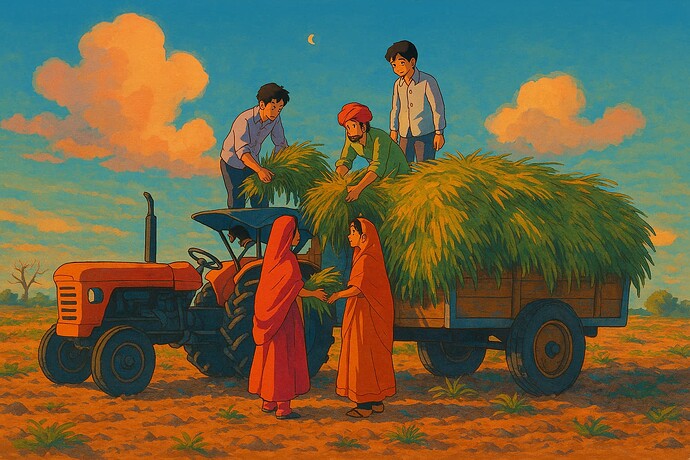As someone who has spent over a decade researching agricultural systems and walking through fields from Punjab to Tamil Nadu, I’ve come to realize that farmers are more than food producers. They are silent architects of social stability, environmental resilience, and rural prosperity. Their work weaves through every thread of community life, often unnoticed but always essential. I will focus on the five powerful ways in which farmers help the community ways I have witnessed firsthand and deeply respect.
1. Ensuring Food Security
It begins with a simple truth: without farmers, we would have no food. From early morning sowing in scorching heat to late-night irrigation under the stars, farmers ensure that our plates are never empty. I recall standing beside a wheat farmer in Madhya Pradesh who, despite erratic rainfall, chose to re-sow half his field to prevent any shortage in the village grain supply. His personal loss was a gain for the community.
In many villages, I’ve seen farmers adjust planting coconut trees and crop varieties just to keep the local mandi and ration shops stocked during tough seasons. Their decisions often prioritize community need over profit. This instinct to protect the food chain makes them irreplaceable during national disruptions like COVID-19, when farmers became the lifeline of uninterrupted supply.
Their contribution goes beyond mere quantity. Increasingly, farmers are embracing organic methods, soil nutrition awareness, and local seed banks to offer food that is not just abundant, but also safe, diverse, and nutritious.
2. Engines of Rural Employment and Enterprise
Farming, contrary to popular belief, is one of the biggest employment creators in our country. Each harvest cycle brings in laborers, tractor drivers, packaging workers, and local traders. During my fieldwork in Maharashtra, I met a woman farmer who had started a small tomato processing unit. She not only cultivated but hired 14 local women to run the enterprise, feeding families beyond her own.
Across India, progressive farmers are experimenting with mixed farming, aquaculture, beekeeping, and mushroom cultivation. These initiatives bring income diversity and reduce risk. More importantly, they are fostering entrepreneurship at the grassroots. In tribal belts of Odisha, I’ve seen young farmers forming FPOs, selling directly to cities, and inspiring others to stay back and transform their land into opportunity.
Their ripple effect sustains shops, transporters, and service providers in the village economy. Every rupee earned on a farm typically circulates multiple times within the community, creating resilience and reducing migration.
3. Preserving Soil and Biodiversity
What most people forget is that farmers are nature’s frontline managers. Every time a farmer switches to compost instead of chemicals, or rotates crops instead of overusing the soil, they are taking a step to heal the planet. I remember a farmer in Himachal who chose to grow cover crops during winter, just to protect the microbial life beneath. “I’m not just farming crops,” he told me, “I’m farming the soil for my grandson.”
Across regions, I’ve seen farmers plant windbreaks, conserve native seeds, and even maintain sacred groves. These actions protect biodiversity and support climate adaptation. In Rajasthan’s dry belts, farmers build farm ponds and use drip irrigation to conserve every drop, a wisdom rooted in centuries of experience, yet aligned with modern climate science.
Their work in sustainability is not theoretical; it is real, practical, and deeply embedded in everyday action with culture of lifestyle. By farming with care, they are literally preserving the lungs and roots of rural India.
4. Anchors of Social Fabric and Knowledge
In most villages, the farmer is more than a cultivator, they’re a counselor, resource guide, and community elder. I’ve been part of panchayat meetings where farmers discussed seed sharing, loan needs, and even school improvements. Their influence shapes decisions not just about agriculture, but also health, education, and community welfare.
In Tamil Nadu, I met an elderly farmer who teaches organic farming to students every Sunday under a neem tree. In his words, “If I don’t pass this on, the land will forget me.” Farmers like him build intergenerational knowledge. They nurture bonds between people and place, something few professions achieve.
Their role in cooperatives, SHGs, and water-user associations promotes transparency and unity. When farmers organize, the village organizes. When they thrive, the community follows.
5. Silent Responders During Crises
Perhaps the most humbling aspect of farmers’ work is their courage during crises. When floods hit Assam or droughts ravage Bundelkhand, farmers are often the first to rebuild, not just their own lives, but others’. I recall a chilling drought year in Bundi district, Rajasthan, where a group of farmers pooled whatever they had to set up a free food kitchen. They had no rain, but they had resilience.
During COVID-19, while cities closed down, rural farmers kept going, harvesting, packaging, sending supplies under lockdown restrictions. They didn’t wait for applause. They didn’t stop for panic. They simply did what they’ve always done: show up for the community.
Their readiness to act without asking for credit makes them pillars of community stability and long-term recovery. In times of crisis, it is the farmer who keeps the village standing tall.
Every field visit renews my respect for our farmers, not just for their labor, but for the dignity, foresight, and responsibility they carry. They don’t wear capes, but they carry the weight of our food, environment, and rural harmony on their shoulders.
To help them is to help ourselves. Because in every community that thrives, somewhere, a farmer has quietly done their part.
